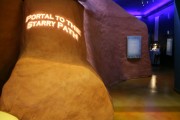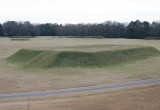Moundville, Alabama's Ancient Indian Mounds Led Souls to the Stars

Moundville, Alabama, April 3, 2016 (Newswire.com) - Many ancient Native American mound and earthwork sites show alignments to the sunrise and sunsets on the solstices and equinoxes. In 1987 the Arkansas Archaeological Survey published astronomical alignment evaluations on 33 mound sites, almost all of which were Mississippian sites. Mississippian sites were generally constructed from A.D. 900-1400. The archaeologists noted that alignments to the solstice sunrises and sunsets were present at most sites and also found that Orion and other stars appeared to be focal points. In addition, their study stressed that “naked eye astronomy” at such sites, where constellations, stars, and the sun were observed from one mound across another mound, required a margin of error because of the vast amount of space that some events encompassed. The 1987 report also noted that the solstice alignments were identified at Moundville, Alabama in 1971. At Moundville, the key viewing area for celestial events was clearly defined as the large central mound, a truncated pyramid presently about 21 feet in height with a base of roughly 200 by 300 feet.
In recent years it has been discovered that America’s mound builders often carefully placed mounds at specific spots to allow for the observation of the rising and setting of stars on the horizon across the tops of mounds and the temples erected on them. Mound location and earthen pathways were determined by these ancient Native American tribes to delineate the exact time for conducting a death ritual. The ritual was designed to aid the souls of deceased tribal members in making the death journey to the “Path of Souls.” The Path of Souls ideology is so accepted today that the Moundville, Alabama Mounds Museum has an audiovisual program devoted to it.
For hundreds of years it has been recognized that the placement of mounds and earthworks was not random but involved topographical/geographical factors and other, then unknown, purposes. The Path of Souls alignments clearly show that many features at such ancient sites were purposely arranged to create alignments with the stars involved in the death ritual.
Dr. Greg Little, Author/Researcher
Star Alignments in the Path of Souls: The Path of Souls ritual involves four key alignments of mounds and earthworks to the horizon. The four key stellar alignments in the Path of Souls journey took place on the Winter Solstice. They are: 1) The place on the horizon where the sun sets on the Winter Solstice; 2) The horizon location where the Cygnus Constellation (or the star Deneb) sets shortly after sunset; 3) The place on the horizon where the Orion Constellation is first seen at sunset; and, 4) The location on the horizon where Orion sets just before dawn. One additional stellar element is needed. That is that the Scorpius Constellation needed to be below the horizon and not visible when the ceremony took place.
The core ideas in the Path of Souls’ death journey are well established and accepted by mainstream archaeology (Little, 2014). It was believed by many Mound Builder tribes that the soul, termed the “free-soul,” made a journey to the stars after death. The journey could only be taken at a time when Scorpius was not visible. This was because Scorpius was believed to be the ruler of the underworld and would snatch the soul.
On the evening of the Winter Solstice, the soul journeyed to the west where it came to a body of water. It then waited till early morning when Orion’s Nebula (Messier-42) was about to descend below the horizon. Orion’s Nebula is the fuzzy spot below the three belt stars of Orion. The ancient mound builders saw the Constellation of Orion as a “hand.” Just before Messier-42 descended below the horizon, the soul made a leap toward the nebula. The nebula was thought to be a slit in the sky, a portal (called an “ogee”) that allowed the soul to pass safely through the underworld during the next day and to the Milky Way. The Milky Way was the Path of Souls. On the path there were various tasks, but the soul eventually made it to a fork in the path: the Dark Rift of the Milky Way. At this split, the soul encountered a judge or mediator represented by a large raptor bird. The Constellation of Cygnus was the bird. If the soul passed the tests, the soul was allowed to make a final journey out of the sky dome.
The Moundville site is a Mississippian Era mound complex that reached its zenith in A.D. 1200. It is considered to be one of the most important archaeological sites in America. It was a 300-acre complex consisting of over 30 large platform mounds arranged in a wide rectangle. A large plaza area was in the center with a single large truncated pyramid in the middle. A huge palisade wall encircled the complex on three sides with the Black Warrior River on the other side. At its peak, 1000 people lived inside the walled complex and another 10,000 lived in the immediate surrounding area. Virtually all of the Path of Souls symbols and iconography have been found at Moundville, thus alignments to the key stars involved in the ritual should be present at the site.
Utilizing the computer program Starry Night Pro, the key stellar alignments in the Path of Souls concept were checked for the Moundville site on the Winter Solstice in A.D. 1200 by Dr. Greg Little, author of The Illustrated Encyclopedia of Native American Mounds & Earthworks. It was assumed that all key alignments to stars would be from the central mound. (Note: The photo of Moundville is a U.S. Air Force photo and the key alignments are noted. All the horizon alignments took place from the central mound across the tops of other mounds arranged around the plaza.)
The first item checked was the visibility of the Scorpius Constellation on the Winter Solstice night. Results showed that Scorpius was below the horizon the entire night rising only after dawn when it could not be seen.
The second alignment was the sunset on the Winter Solstice. From the central mound the sunset would have appeared directly over a square, truncated mound. The next alignment tested the visibility and actions of Cygnus. At dusk, Cygnus was visible on the northwest horizon and it fell below the horizon at 11:03 PM. As viewed from the central mound, the setting of Cygnus was directly over a large truncated mound to the northwest. The final alignments checked were the rising and setting of Orion. At 7:15 PM Orion was seen to rise on the southeast horizon directly over a mound situated close to the central mound. It traversed the sky to the west until 5:43 AM when it set nearly due west directly over another truncated mound. Finally, the Black Warrior River bends sharply to the west of Moundville, serving as the body of water where the soul had to wait.
A wide variety of other Mississippian sites have also been checked for these same stellar alignments. Virtually all mound complexes arranged around central plazas appear to show the same features. For hundreds of years it has been recognized that the placement of mounds and earthworks was not random but involved topographical/geographical factors and other, then unknown, purposes. The Path of Souls alignments clearly show that many features at such ancient sites were purposely arranged to create alignments with the stars involved in the death ritual.



